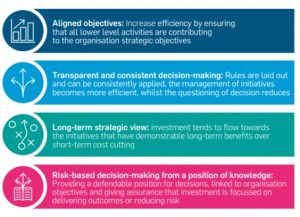Fleet management and asset management are terminologies widely used in the defence domain, but through life asset management is definitely new. Pierre-Michael Delamotte, professional head of discipline at Atkins, explains
In his Defence Support Strategy (DSS), the Chief Defence Logistic and Support (CDLS), Lt Gen Richard Wardlaw, identified the installation and exploitation of through life asset management as one of the ways to achieve the strategic outcomes he has set for 2025.
The choice of this new term ‘through life asset management’ would indicate a willingness from the CDLS to adopt some of the principles of ISO 55000 Asset Management, as expressed in one of his responses during the Q&A session at SupportNet21, held on May 18 2021.
Some MOD organisations are already on this journey, such as FinMilCap and the Defence Infrastructure Organisation (DIO) applying asset management to the Defence Estate assets, or the Submarine Delivery Agency (SDA) doing the same for their Infrastructure and Equipment assets. Using through life asset management may also highlight a difference with what is commonly described in MOD as fleet/asset management that refers in reality to managing assets. Indeed, this source of confusion is not specific to Defence and is well explained in the TC251 article ‘Managing Assets in the context of Asset Management‘.
| A managing assets focus | An asset management focus |
| • Lifecycle activities and asset care – availability, reliability, dependability and safety
• Asset location, condition, life extension and/or interventions • Asset databases, systems (and IT) and performance • People, skills and work management • Budgets and key performance indicators (KPIs) / cost of maintenance and current performance |
• The purpose of your organisation and what assets it needs – and why
• Value, purpose and long-term outcomes • Risk and context e.g. markets / climate / regulation • Holistic approach to different funding streams e.g. CAPEX and OPEX? • Collaborative behaviours – breaking down silos both internal and supply chain? • How assets contribute to organisational value |
ISO 55000 Standards
The ISO 55000 Standards predominantly address the strategies, plans and management system framework an organisation uses to derive value from the assets.
Whilst they do not in detail address the activities performed directly on the assets (managing assets) they do provide a structured approach and a home to connect those activities that are already well defined elsewhere in systems engineering, ARM&T, Safety or Supportability disciplines.
The additional benefit of the wider asset management approach is that it provides that essential linkage between assets and the delivery of sustained military capability expressed in terms that are more easily digestible by those in control of the finances than a very engineering led approach.

Supportability Case:
What could through life asset management mean for the current processes and artefacts developed collectively by the Defence Enterprise if the principles of ISO 55000 were applied?
Let’s consider one example by picking the Supportability Case; a key ILS artefact and a major input to the Support Solution Envelope (SSE).
As defined in the Defence Logistic Framework (DLF), the Supportability Case is defined as: “A reasoned, auditable argument created to support the contention that a defined system will satisfy the Support requirements of a Project”.
Starting with the initial statement of requirement, it will subsequently include identified perceived and actual risks, strategies and an Evidence Framework. This refers to associated and supporting information, including Support related evidence and data from design activities, trials, etc, through to In-Service and field data as appropriate, and also record any changes.
In other terms, the Supportability Case is a progressively expanded body of evidence that provides progressive assurance that an asset will achieve its support requirements and that the support risks are managed.
The Supportability Case already satisfies many asset management principles:
- Risk-based decision making, where identified support risks are assessed to determine the Supportability activities required to mitigate these risks, resulting in the tailoring of the supportability programme.
- Long term view, as the asset in-service life (30-50 years) is a key parameter in the supportability analyses. Furthermore, the Supportability Case is updated periodically to record progress, changes and assumptions firming-up. It will remain with the asset throughout its life, from concept to disposal.
- Decision making from a position of knowledge, as the claims made in the Supportability Case must be evidenced and provide a clear audit trail. The nature of the evidence evolves during the life of the Supportability Case starting from requirements allocation, progressing then to design predictions, test results, logistic demonstration reports and in-service monitoring of supportability performance.
To satisfy the asset management principles, the Supportability Case should also provide the following:
- Alignment with the Capability objectives and Organisation objectives, understanding how the achieving the Support requirements are contributing to the delivery of Military Capability and the MOD objectives.
- Decision-making criteria consistent across the functions delivering the asset, allowing to prioritise funding alongside other functions, such as safety, reliability, design engineering, supply chain, etc.
- A link between very technical Asset Risk and more holistic Enterprise Risk (as espoused in JSP892).
Adopting the principles of ISO 55000 is entirely feasible and relates more to improvements than to revolutionising the current approach. This could be because MOD already has a mature approach in managing its assets. Obviously, this analysis should be extended to a much wider part of the MOD Business Enterprise before firm conclusions are made.

















